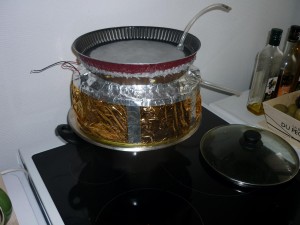after the previous results, it was necessary to add or change a few things on the generator to try to make it more efficient; the cold side has been changed in a water tank (i have welded an another alu mold on the edges of the first mold “cold part”), sponge parts have been removed, and the hot side isolation has been improved with several layers and mastic. regarding our thing mirrors have been removed too and changed with a silver sun visor (more efficient and cheap, and easier to find in second hand), pvc window has been changed with double glazing to improve isolation.
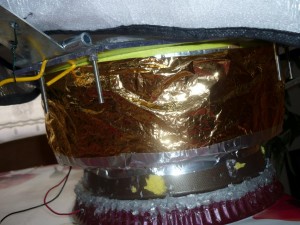 on the picture we see molds, and silicon on the link to seal everything.
on the picture we see molds, and silicon on the link to seal everything.
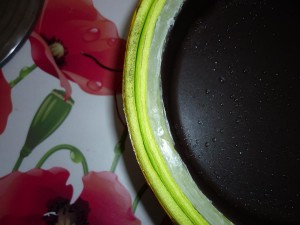 three isolating layers have been added up, stuck everytime with mastic. on the edge's mold “heat part” i have made a flat mastic seal on the top to improve isolation. when the window is put, it pushes first on the isolating moss and in a second time it touches the seal (to avoid hot losses).
three isolating layers have been added up, stuck everytime with mastic. on the edge's mold “heat part” i have made a flat mastic seal on the top to improve isolation. when the window is put, it pushes first on the isolating moss and in a second time it touches the seal (to avoid hot losses).
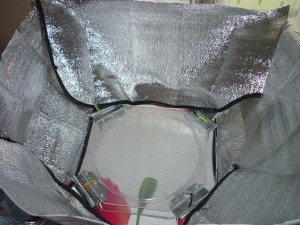 i have kept hinges and hangers, but this time to catch more light i have cut a sun visor 4 in four parts.
i have kept hinges and hangers, but this time to catch more light i have cut a sun visor 4 in four parts.
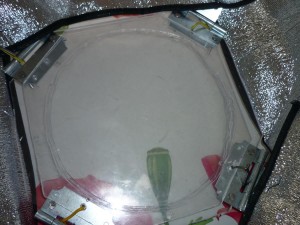 on the window used at the beginning i have stuck a second window, between them i have let a little space 5 mm roughly. by this way we get double glazing able to improve isolation.
on the window used at the beginning i have stuck a second window, between them i have let a little space 5 mm roughly. by this way we get double glazing able to improve isolation.
1) solar energy
when our generator is used with sun, like a solar oven it must be set up in face with solar energy; or sun is never moveless in the sky so it must be moved steadily because we have to follow the sun. To have a good link between sun visor, window and our pile’ to avoid hot loss as well as possible, i have used sandows.
by an october normandy day well sunny, not overcast at all, and with water 15 degrees used like a cooling system we get that :
14h55: departure
/15h00: 2 V and 74 mA
/15h10: 2.45 V and 88 mA
/15h20: 2.7 V and 97 mA
/15h30: 2.62 V and 87 mA
/15h40: 2.71 V and 98 mA
/15h50: 2.92 V and 103 mA
/16h05: 2.73 V and 90 mA
/16h15: 2.75 V and 92 mA
/16h25: 2.56 V and 87 mA.
still in october, this time with some clouds:
16h20: 0.6 V and 20 mA
/16h25: 1.57 V and 58 mA(and sunrays)
/16h31: 2.55 V and 83 mA(then a fat cloud comes)
/16h40: 1.75 V and 63 mA (and sunrays again)
/16h50: 2.65 V and 95 mA
/17h00: 2.63 V and 95 mA
/17h10: 2.7V and 96mA (then overcast again)
/17h20: 0.8V et 23mA.
Conclusion: compared with our first try (done in summer, in august) we get roughly 1 V and more intensity. we could improve it; by increasing thermal isolation, and why not by improving water cooling system (which tends to heat up in time, thus lowering the voltage got since the beginning).
2) boiling water
as we have seen at the beginning, we could not indefinitely heat peltier modules, if we exceed 100 degrés , we could damage it. if we heat them with water steam from boiling water we will be sure to stay under this limit 100 degrees , then to protect our system. we set up the heat side of our pile down on an aluminium lid perforated to let water steam run, then all on a water boiling recipient :
there is no contact between the pile and the aluminium lid thanks to mastic added up on our mold edge “heat part” and moss isolation. having filled up cold part with water at 15 degrees we get those following results:
16h13: the beginning
/16h15: 0.5 V and 23 mA
/16h20: 7.53 V and 2.3 A
/16h25: 7.41 V and 2.5 A
/16h30: 6.23V et 2A
/16h35: 5.19V and 1.8A /
16h40: 3.9V et 1.4A
/16h45: 3.4V and 1.1A.
At the end cooling water was at 29.5 degrees .
Conclusion of our story:
to get an efficient thermal pile, it is needfull to have a heat circulation as good as possible beetween heat and cold parts (i think that heat should be seen like a river that would have to keep a steady debit to move our mill's wheel, so our modules). So we will try to do 2 separate piles; one pile working with sun and an another working with fuel (wood or oil for exemple).
for the sun pile i will try to make a wooden isolated box heated by fresnel lenses and cooled with air or water, and the other we will see (probably heated with combustible then cooled with water).
